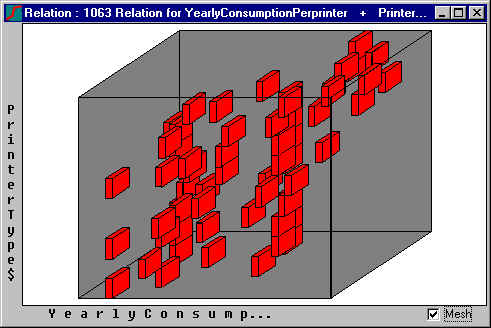

The format of the RELATION operator is:
Control@ EQV RELATION(MinerState, Memory, Variable_1, Variable_2,...)
(the operator is usually built by the Data Miner, either automatically or under user control)
The operator links two or more variables, providing a graph of the relation among them, internally constructed during the Learning phase. The graph is constructed based on the pre-existence of DISTRIB operators on the variables. The RELATION operator is not active during the Run phase, merely providing a repository of information for the DISTRIB operators to use.
The parameters control the operation of the RELATION function:
 Control@ -
if TRUE, the function will respond to the state of the Miner, storing information or
protecting its contents from change. If not TRUE, nothing happens.
Control@ -
if TRUE, the function will respond to the state of the Miner, storing information or
protecting its contents from change. If not TRUE, nothing happens.
MinerState - the MinerState can be Quiescent, StartLearn, Learn, FinishLearn or Run. If Learning, the information coming in from the variables is constructed into a multi-dimensional graph, for later use by a DISTRIB function. Setting MinerState to StartLearn will destroy the internal graph, and reset it for a new Learn phase.
The RELATION operator handles both string and numeric variables, or any combination. The number of variables which can be connected has a limit of 10, although 4 or 5 are more realistic, given likely ranges. The maximum number of points for 2 variables is 96 X 96 - more than two variables are mapped into the internal array, with space saving if the array is sparse.
The graph stored in the operator need not have linear axes - it is necessary to refer to the DISTRIB operators to evaluate the meaning of distance on the axes. The graph can be viewed by using PieceLine.
 The graph built by the RELATION operator can be used to build analytic
structure to better describe a relation that is approximately piecewise linear. The
RELATION operator is particularly useful when the behaviour is too complex to be easily
described analytically, or when partial information will be present on one or more axes,
rendering a neural net useless.
The graph built by the RELATION operator can be used to build analytic
structure to better describe a relation that is approximately piecewise linear. The
RELATION operator is particularly useful when the behaviour is too complex to be easily
described analytically, or when partial information will be present on one or more axes,
rendering a neural net useless.
Related Functions: